Continental Grand Prix 5000 Endurance Test
Contents
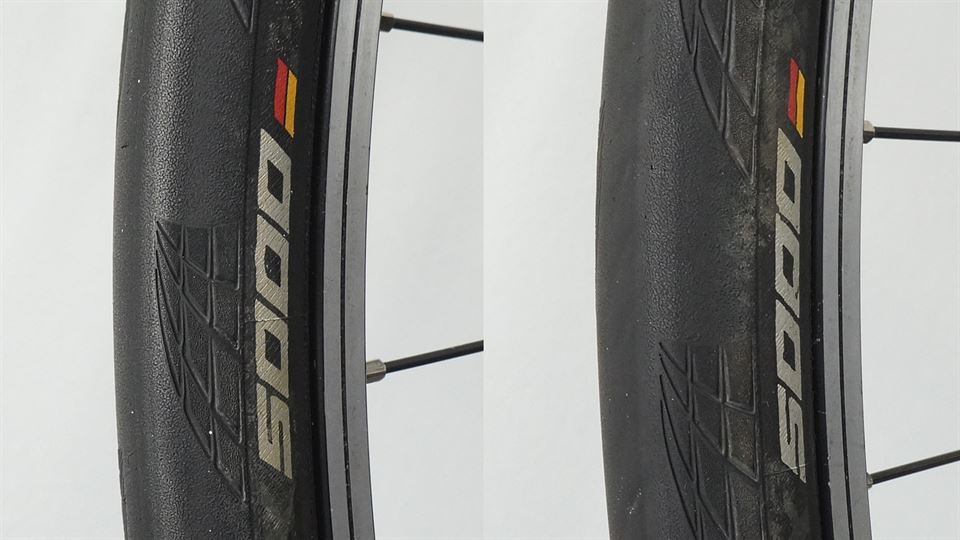
Update 2021-11-19: We've added the 3720 miles / 6000 km results.
We also added some data from a worn Wolfpack Road Race sample sent in by a member.
This is an endurance road test of a pair of Continental Grand Prix 5000 (go here for our full review of the GP 5000) that will be tested on our rolling resistance test machine every 620 miles / 1000 km. This test will take a while to complete as we expect to cycle about 62 miles / 100 km per week with an update to this article every 2-3 months.
Ad Buy Continental Grand Prix 5000 at Amazon.com
We've already done a test with a pair of worn Grand Prix 4000S II that was sent in by a reader who used them for 5000 miles / 8000 km. Because we received a lot of comments about the cracked rubber of that pair of Grand Prix 4000S II, we've decided to do an even better test with measurements every 620 miles / 1000 km. These measurements will give us valuable information about how the tires behave over their entire life cycle.
The bike (and tires) used for this test is stored in an underground basement where the ambient temperature is between 10 - 15 C year-round. There will be zero exposure to sunlight when the bike is in storage. We think these conditions are the best possible conditions to store tires so take this into account when reading the results.
Both the front 28-622 and rear 32-622 are inflated to an air pressure of 65 psi / 4.5 bars (checked every ride) that provides a relatively comfortable ride. Rider weight with gear is close to 75 kg and bike weight is 10kg.
On the road, we use latex tubes filled with tire sealant in both the front and rear tires. The tests are performed with a Continental Race 28 Wide inner tube that is only used for this test.
Sixth Update at 3720 miles / 6000 km
This latest update at 3720 miles / 6000 km is very much the same as the results at 3100 miles / 5000 km.
The tread thickness and weight of both the front and rear tires have gone down a bit more, but we can't find any surprises anywhere. Rolling resistance is nearly the same as the previous measurements.
The decreased tread thickness of the rear tire still doesn't seem to affect the puncture resistance as we're still at 0 flat tires over the current distance.
There is new data of a worn Wolfpack Road Race that was sent in by a member. The Wolfpack also shows some 10% more rolling resistance when worn, so it looks like the Grand Prix 5000 isn't the only tire that suffers from increased rolling resistance.
Ride Statistics and Visual Inspection
| Ride statistics | ||||||
|---|---|---|---|---|---|---|
| Distance | Days on bike |
Wet roads |
Dry roads |
Average temp |
Average speed |
Flat tires |
| 620 miles 1000 km |
180 | 101 miles 162 km |
523 miles 838 km |
12.5 C | 17.6 mph 28.2 km/h |
0 |
| 1240 miles 2000 km |
91 | 107 miles 171 km |
518 miles 829 km |
18.3 C | 18.3 mph 29.3 km/h |
0 |
| 1860 miles 3000 km |
195 | 111 miles 178 km |
511 miles 822 km |
12.9 C | 17.7 mph 28.5 km/h |
0 |
| 2480 miles 4000 km |
136 | 47 miles 75 km |
573 miles 925 km |
18.6C | 17.6 mph 28.2 km/h |
0 |
| 3100 miles 5000 km |
200 | 124 miles 199 km |
496 miles 801 km |
12.1 C | 16.9 mph 27.1 km/h |
0 |
| 3720 miles 6000 km |
175 | 28 miles 45 km |
592 miles 955 km |
17.9C | 17.3 mph 27.8 km/h |
0 |
| Total | 977 | 516 miles 830 km |
3207 miles 5170 km |
15.4 C | 27.5 mph 28.2 km/h |
0 |
All riding was done during the summer, which shows in the average temperature. The distance on wet roads also was the lowest of any other update.
The wear of the rear tire (in grams) is much lower this time, and it will be interesting to see the next update if wear increases again. That would indicate higher wear on wet and cold roads due to (micro) slippage.
The rear tire now also started showing some kind of toothing effect that can be felt when rubbing my hand over the tread. Looking back at pictures from the 3100 miles / 5000 km update, it already was visible there, but it's gotten a bit worse.
GP 5000 28-622 (front) Condition After 3720 Miles / 6000 km:
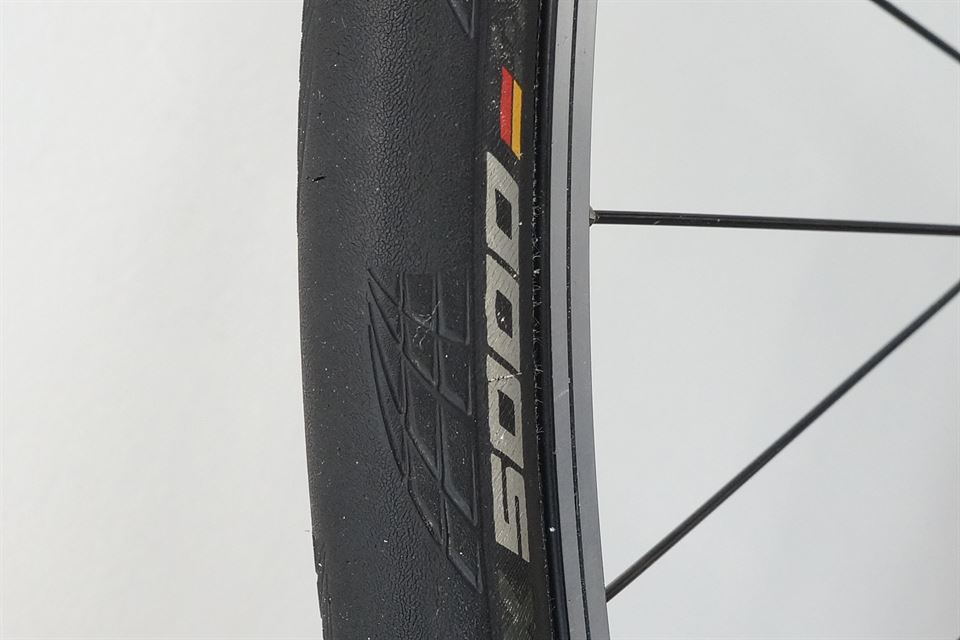
GP 5000 32-622 (rear) Condition After 3720 Miles / 6000 km:
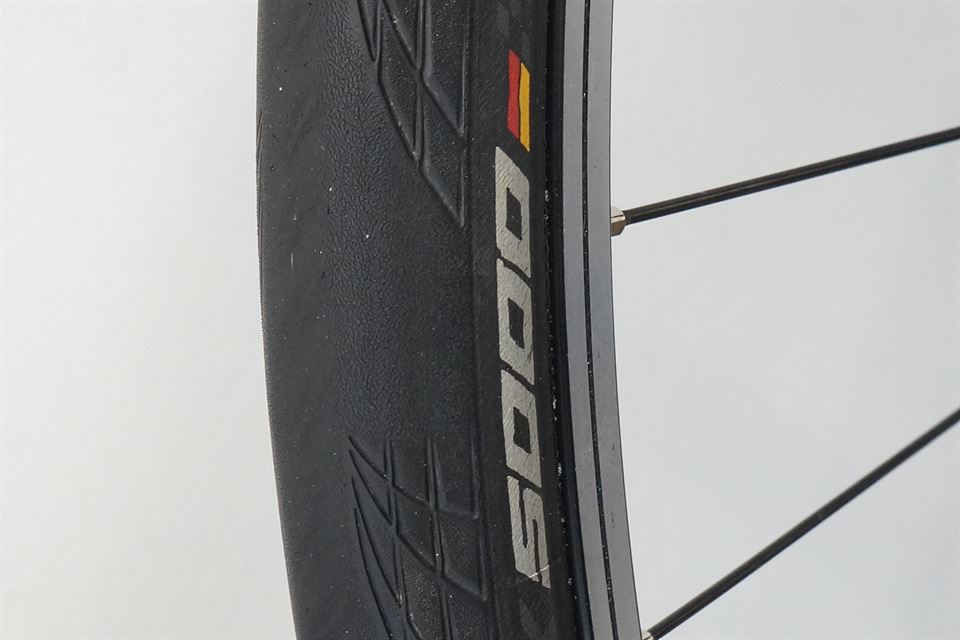
Front 28-622 Measurements After 3720 Miles / 6000 km
| Measurements GP 5000 28-622 (front) | |||||||
|---|---|---|---|---|---|---|---|
| Distance | Weight | Width | Wear marker |
Tread thickness |
RR 100 psi 6.9 bars |
RR 80 psi 5.5 bars |
RR 60 psi 4.1 bars |
| 0 miles 0 km |
235 grams | 28.5 mm | 0.70 mm | 2.6 mm | 10.3 Watts | 11.5 Watts | 14.1 Watts |
| 620 miles 1000 km |
233 grams | 29.0 mm | 0.65 mm | 2.6 mm | 11.2 Watts | 11.5 Watts | 14.1 Watts |
| 1240 miles 2000 km |
233 grams | 29.1 mm | 0.65 mm | 2.5 mm | 11.3 Watts | 12.5 Watts | 14.6 Watts |
| 1860 miles 3000 km |
233 grams | 29.1 mm | 0.65 mm | 2.5 mm | 11.4 Watts | 12.3 Watts | 14.6 Watts |
| 2480 miles 4000 km |
233 grams | 29.2 mm | 0.65 mm | 2.5 mm | 11.5 Watts | 12.8 Watts | 14.9 Watts |
| 3100 miles 5000 km |
232 grams | 29.2 mm | 0.65 mm | 2.5 mm | 11.4 Watts | 12.9 Watts | 14.7 Watts |
| 3720 miles 6000 km |
230 grams | 29.2 mm | 0.60 mm | 2.4 mm | 11.3 Watts | 12.5 Watts | 14.7 Watts |
The 28-622 Grand Prix 5000 on the front now dropped to a tread thickness of 2.4 mm and a weight of 230 grams. From its looks, it should still easily make it to 12500 miles / 20000 km if the casing and the rest of the tire holds up.
The rolling resistance still looks very stable, and the latest measurements are very much in line with the previous measurements. The good thing is that it's now becoming clear that most of the increase in rolling resistance happens in the first 1240 miles / 2000 km.
Rear 32-622 Measurements After 3720 Miles / 6000 km
| Measurements GP 5000 32-622 (rear) | |||||||
|---|---|---|---|---|---|---|---|
| Distance | Weight | Width | Wear marker |
Tread thickness |
RR 100 psi 6.9 bars |
RR 80 psi 5.5 bars |
RR 60 psi 4.1 bars |
| 0 miles 0 km |
278 grams | 31.8 mm | 0.90 mm | 2.7 mm | 9.7 Watts | 11.0 Watts | 12.9 Watts |
| 620 miles 1000 km |
274 grams | 32.4 mm | 0.80 mm | 2.5 mm | 10.5 Watts | 11.7 Watts | 13.6 Watts |
| 1240 miles 2000 km |
273 grams | 32.6 mm | 0.70 mm | 2.4 mm | 10.8 Watts | 12.1 Watts | 14.0 Watts |
| 1860 miles 3000 km |
271 grams | 32.7 mm | 0.65 mm | 2.4 mm | 11.3 Watts | 12.3 Watts | 14.4 Watts |
| 2480 miles 4000 km |
270 grams | 32.8 mm | 0.60 mm | 2.4 mm | 12.0 Watts | 13.2 Watts | 15.2 Watts |
| 3100 miles 5000 km |
265 grams | 32.9 mm | 0.50 mm | 2.3 mm | 11.4 Watts | 12.3 Watts | 14.0 Watts |
| 3720 miles 6000 km |
263 grams | 32.9 mm | 0.40 mm | 2.2 mm | 11.2 Watts | 12.4 Watts | 14.2 Watts |
The rear tire again shows much higher wear than the front tire. Another 0.1 mm has worn off, and weight has decreased by 2 grams. From its looks, it should last about 6200 miles / 10000 km, depending on how the rest of the tire holds up.
Rolling resistance is very much the same as it was the last time. The following measurements will be more interesting as we expect rolling resistance to go down again as the tread gets thinner.
Conclusion After 3720 Miles / 6000 km.
This probably was the most boring update of all updates as there isn't much that's different from the previous update. Tread thickness and weight have decreased as expected, but it didn't seem to affect the rolling resistance of both tires at all.
No punctures yet, so nothing new there as well. We're curious to see how the puncture resistance holds up over the following updates as the tread of the rear tire now is getting thinner and small pieces of glass will get a better chance of cutting through the casing.
The most interesting of this update is probably the data from the worn Wolfpack Road Race that was sent in by a member: worn Wolfpack Road Race. The Wolfpack also shows an increase in rolling resistance of about 10% compared to a new tire. This might be a first indication that the Grand Prix 5000 is not the only tire affected by increased rolling resistance.
Ad Buy Continental Grand Prix 5000 at Amazon.com
Fifth Update at 3100 miles / 5000 km
It again took way too much time to reach 3100 miles / 5000 km. The biggest problem is a bad knee that gets worse when it's cold outside :(
I still didn't experience any problems, slides, or flat tires with this set of Grand Prix 5000. I did have some problems with the latex tubes I've been using since the start of this test; they both burst near the valve when trying to inflate them with a floor pump. Luckily, both times I was at home when this happened.
This time around, the rear 32-622 GP5000 shows a decreased rolling resistance when compared to the last measurement at 2380 miles / 4000 km. Maybe we've now reached the point where rolling resistance starts to go down again which would be nice to see.
I also added data of some worn Grand Prix 5000 samples that were sent in by website visitors. Although these are all the smaller 25-622 size that should wear out faster and also wear down a larger part of the tread, the data from these tires does seem to suggest that rolling resistance when fully worn should be near or slightly under the new state.
Ride Statistics and Visual Inspection
| Ride statistics | ||||||
|---|---|---|---|---|---|---|
| 1st update | 2nd update | 3rd update | 4th update | 5th update | Total | |
| Days on bike | 180 days | 91 days | 195 days | 136 days | 200 days | 802 days |
| Total distance | 620 miles 1000 km |
620 miles 1000 km |
620 miles 1000 km |
620 miles 1000 km |
620 miles 1000 km |
3100 miles 5000 km |
| Wet roads | 101 miles 162 km |
107 miles 171 km |
111 miles 178 km |
47 miles 75 km |
124 miles 199 km |
488 miles 785 km |
| Dry roads | 523 miles 838 km |
518 miles 829 km |
511 miles 822 km |
573 miles 925 km |
496 miles 801 km |
2615 miles 4215 km |
| Average temperature | 12.5 C | 18.3 C | 12.9 C | 18.6 C | 12.1 C | 14.9 C |
| Average speed | 17.6 mph 28.2 km/h |
18.3 mph 29.3 km/h |
17.7 mph 28.5 km/h |
17.6 mph 28.2 km/h |
16.9 mph 27.1 km/h |
17.6 mph 28.3 km/h |
| Inflation pressure | 65 psi 4.5 bars |
65 psi 4.5 bars |
65 psi 4.5 bars |
65 psi 4.5 bars |
65 psi 4.5 bars |
65 psi 4.5 bars |
| Flat tires | 0 | 0 | 0 | 0 | 0 | 0 |
We had quite a cold, wet, and long winter here which shows in the average temperature and number of miles on wet roads. Average speed dropped quite dramatically because I just didn't ride enough.
Better weather now arrived and I should be able to start improving both in miles/week and average speed.
GP 5000 28-622 (front) Condition After 3100 Miles / 5000 km:

GP 5000 32-622 (rear) Condition After 3100 Miles / 5000 km:
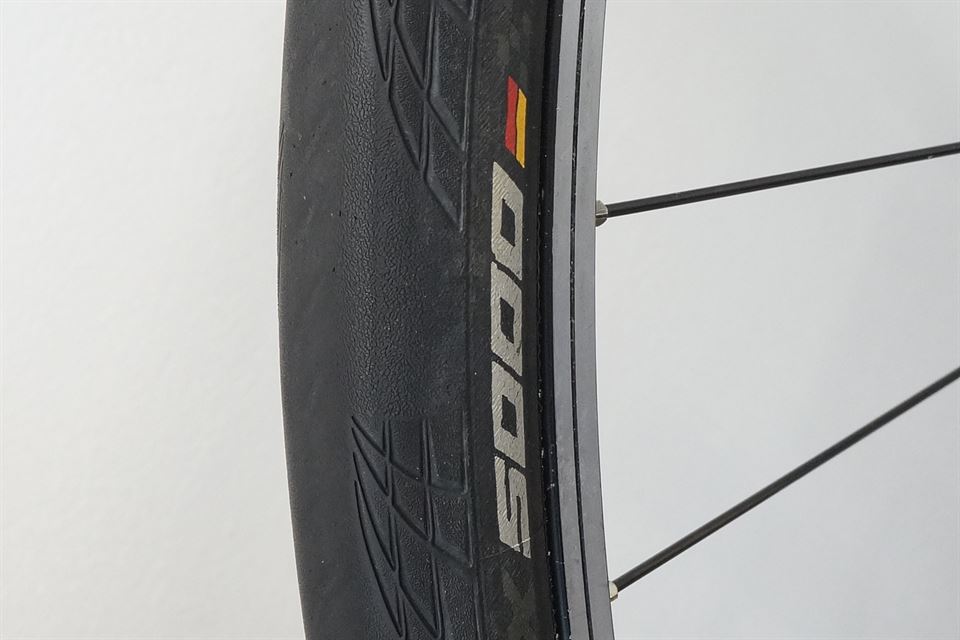
Front 28-622 Measurements After 3100 Miles / 5000 km
| Measurements GP 5000 28-622 (front) | ||||||
|---|---|---|---|---|---|---|
| Distance | 0 miles 0 km |
620 miles 1000 km |
1240 miles 2000 km |
1860 miles 3000 km |
2480 miles 4000 km |
3100 miles 5000 km |
| Weight | 235 grams | 233 grams | 233 grams | 233 grams | 233 grams | 232 grams |
| Wear marker | 0.70 mm | 0.65 mm | 0.65 mm | 0.65 mm | 0.65 mm | 0.65 mm |
| Tread thickness | 2.6 mm | 2.6 mm | 2.5 mm | 2.5 mm | 2.5 mm | 2.5 mm |
| Width | 28.5 mm | 29.0 mm | 29.1 mm | 29.1 mm | 29.2 mm | 29.2 mm |
| Rolling resistance 100 psi 6.9 bars |
10.3 Watts | 11.2 Watts | 11.3 Watts | 11.4 Watts | 11.5 Watts | 11.4 Watts |
| Rolling resistance 80 psi 5.5 bars |
11.5 Watts | 12.2 Watts | 12.5 Watts | 12.3 Watts | 12.8 Watts | 12.9 Watts |
| Rolling resistance 60 psi 4.1 bars |
14.1 Watts | 14.6 Watts | 14.9 Watts | 14.6 Watts | 14.9 Watts | 14.7 Watts |
There still is hardly any wear on the front tire at 3100 miles / 5000 km. I guess this is the result of riding long, flat stretches at constant speeds that require nearly no turning or braking. I'll never be able to wear this tire out, but maybe that's a good thing from a data perspective as it's so different when compared to the rear tire.
It looks like rolling resistance has been quite stable over the last 1860 miles / 3000 km after the initial increase that we've seen over the first 1240 miles / 2000km. The total increase in rolling resistance is also much less than the larger 32-622 version of the Grand Prix 5000 on the rear wheel.
Rear 32-622 Measurements After 3100 Miles / 5000 km
| Measurements GP 5000 32-622 (rear) | ||||||
|---|---|---|---|---|---|---|
| Distance | 0 miles 0 km |
620 miles 1000 km |
1240 miles 2000 km |
1860 miles 3000 km |
2480 miles 4000 km |
3100 miles 5000 km |
| Weight | 278 grams | 274 grams | 273 grams | 271 grams | 270 grams | 265 grams |
| Wear marker | 0.90 mm | 0.80 mm | 0.70 mm | 0.65 mm | 0.60 mm | 0.50 mm |
| Tread thickness | 2.7 mm | 2.5 mm | 2.4 mm | 2.4 mm | 2.4 mm | 2.3 mm |
| Width | 31.8 mm | 32.4 mm | 32.6 mm | 32.7 mm | 32.8 mm | 32.9 mm |
| Rolling resistance 100 psi 6.9 bars |
9.7 Watts | 10.5 Watts | 10.8 Watts | 11.3 Watts | 12.0 Watts | 11.4 Watts |
| Rolling resistance 80 psi 5.5 bars |
11.0 Watts | 11.7 Watts | 12.1 Watts | 12.4 Watts | 13.2 Watts | 12.3 Watts |
| Rolling resistance 60 psi 4.1 bars |
12.9 Watts | 13.6 Watts | 14.0 Watts | 14.4 Watts | 15.2 Watts | 14.0 Watts |
Finally, it's getting interesting. The rear tire now shows a lower rolling resistance than the 2480 miles / 4000 km measurement. For some reason, wear of the rear tire was very high this time around as weight decreased by 5 grams while previously it was only 1-2 grams per 620 miles / 1000 km.
The next results will be very interesting to see what's going to happen next.
Conclusion After 3100 Miles / 5000 km.
Both the front 28-622 and rear 32-622 Grand Prix 5000 still look very good and still provide enough puncture resistance for the type of riding I do.
The increase in rolling resistance that we've observed in the first 2480 miles / 4000 km now seems to have stabilized with the rear 32-622 even showing a decreased rolling resistance at the latest measurement.
From data of several other worn samples of the Grand Prix 5000 that were sent in by readers, it seems highly likely that rolling resistance will go down again from this point for at least the rear 32-622 Grand Prix 5000 that shows decent wear. The front 28-622 just doesn't wear at all with the type of riding we do, and we're unsure how this affects the future results.
We do have to consider that the sent-in samples all were of the 25-622 size, and the smaller tires will wear down a (relative) wider part of the tread at a faster rate. This is also a trend we see with our 28-622 and 32-622 versions of the Grand Prix 5000, with the bigger size showing a bigger increase in rolling resistance.
It might be that the 25-622 versions, or bigger versions under circumstances where the wear rate is much higher, will see a much smaller increase in rolling resistance during the first 1240 miles / 2000 km.
We'll keep on going with these tires and look forward to the next measurements.
Fourth Update at 2480 miles / 4000 km
Ride Statistics and Visual Inspection
| Ride statistics | |||||
|---|---|---|---|---|---|
| First update | Second update | Third update | Fourth update | Total | |
| Days on bike | 180 days | 91 days | 195 days | 136 days | 602 days |
| Total distance | 620 miles 1000 km |
620 miles 1000 km |
620 miles 1000 km |
620 miles 1000 km |
2480 miles 4000 km |
| Wet roads | 101 miles 162 km |
107 miles 171 km |
111 miles 178 km |
47 miles 75 km |
364 miles 586 km |
| Dry roads | 523 miles 838 km |
518 miles 829 km |
511 miles 822 km |
573 miles 925 km |
2119 miles 3414 km |
| Average temperature | 12.5 C | 18.3 C | 12.9 C | 18.6 C | 15.6 C |
| Average speed | 17.6 mph 28.2 km/h |
18.3 mph 29.3 km/h |
17.7 mph 28.5 km/h |
17.6 mph 28.2 km/h |
17.8 mph 28.6 km/h |
| Inflation pressure | 65 psi 4.5 bars |
65 psi 4.5 bars |
65 psi 4.5 bars |
65 psi 4.5 bars |
65 psi 4.5 bars |
| Flat tires | 0 | 0 | 0 | 0 | 0 |
Visually, there is little difference from the 1860 miles / 3000 km test. The front tire still shows very little wear with no flat spotting yet. The rear tire shows some wear and is starting to square off a bit, but nothing alarming yet. The rubber also still looks in great shape with no visual cracking yet. I did spot a little damage to the sidewall with some casing wires cut but again nothing serious.
Again, it took me a lot of time to reach the 620 miles / 1000 km. I now hope to be able to reach the 3100 miles / 5000 km target within 2 years of having the tires on the bike. At that point, I'll review if it's still interesting to keep running these tires or if a new endurance test with different tires might give better data.
Again, still no flat tire yet with this pair of Grand Prix 5000.
GP 5000 28-622 (front) Condition After 2480 Miles / 4000 km:
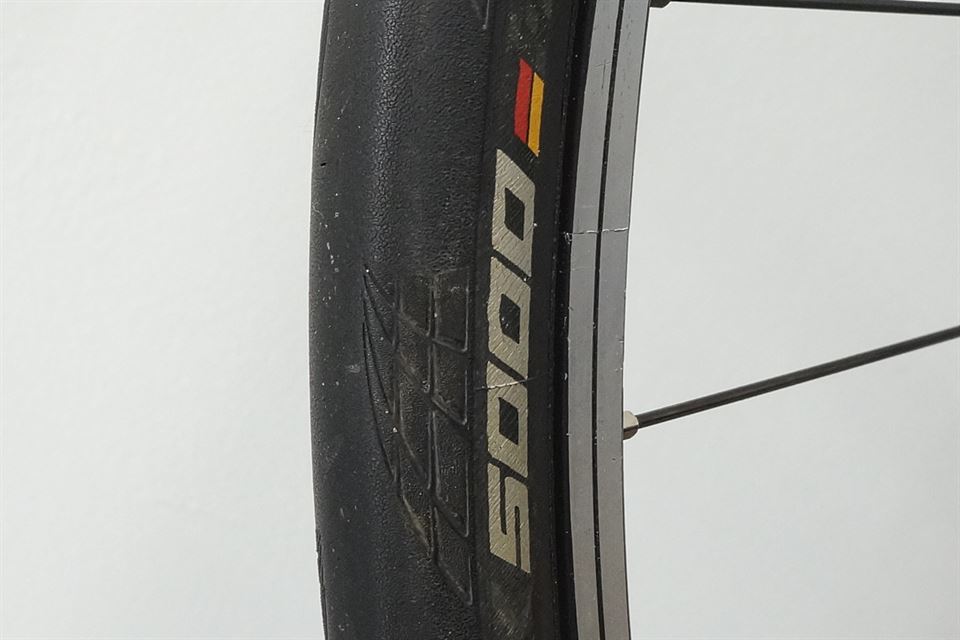
GP 5000 32-622 (rear) Condition After 2480 Miles / 4000 km:
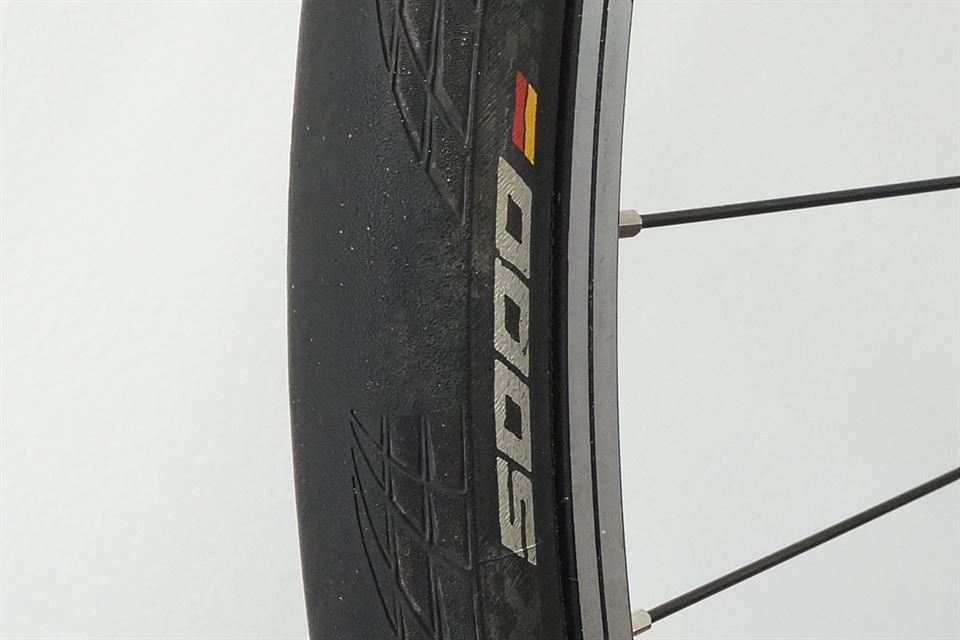
Front 28-622 Measurements After 2480 Miles / 4000 km
| Measurements GP 5000 28-622 (front) | |||||
|---|---|---|---|---|---|
| Distance | 0 miles 0 km |
620 miles 1000 km |
1240 miles 2000 km |
1860 miles 3000 km |
2480 miles 4000 km |
| Weight | 235 grams | 233 grams | 233 grams | 233 grams | 233 grams |
| Wear marker | 0.70 mm | 0.65 mm | 0.65 mm | 0.65 mm | 0.65 mm |
| Tread thickness | 2.6 mm | 2.6 mm | 2.5 mm | 2.5 mm | 2.5 mm |
| Width | 28.5 mm | 29.0 mm | 29.1 mm | 29.1 mm | 29.2 mm |
| Rolling resistance 100 psi 6.9 bars |
10.3 Watts | 11.2 Watts | 11.3 Watts | 11.4 Watts | 11.5 Watts |
| Rolling resistance 80 psi 5.5 bars |
11.5 Watts | 12.2 Watts | 12.5 Watts | 12.3 Watts | 12.8 Watts |
| Rolling resistance 60 psi 4.1 bars |
14.1 Watts | 14.6 Watts | 14.9 Watts | 14.6 Watts | 14.9 Watts |
The numbers show the 28-622 front Grand Prix 5000 hardly wears with my type of riding (no climbing, just a lot of long flat roads). From a tread thickness perspective, this tire could probably last for more than 12500 miles / 20000 km. The rest of the tire probably will wear out before the tread does.
The tire has stretched a tiny bit more and now measures 29.2 mm wide.
While it looked like rolling resistance had stabilized at the 1860 miles / 3000 km measurement, the latest measurement again shows a small increase in rolling resistance. The increased rolling resistance of the front tire still looks acceptable as it's still within ~10% of the new tire measurement.
| Measurements GP 5000 32-622 (rear) | |||||
|---|---|---|---|---|---|
| Distance | 0 miles 0 km |
620 miles 1000 km |
1240 miles 2000 km |
1860 miles 3000 km |
2480 miles 4000 km |
| Weight | 278 grams | 274 grams | 273 grams | 271 grams | 270 grams |
| Wear marker | 0.90 mm | 0.80 mm | 0.70 mm | 0.65 mm | 0.60 mm |
| Tread thickness | 2.7 mm | 2.5 mm | 2.4 mm | 2.4 mm | 2.4 mm |
| Width | 31.8 mm | 32.4 mm | 32.6 mm | 32.7 mm | 32.8 mm |
| Rolling resistance 100 psi 6.9 bars |
9.7 Watts | 10.5 Watts | 10.8 Watts | 11.3 Watts | 12.0 Watts |
| Rolling resistance 80 psi 5.5 bars |
11.0 Watts | 11.7 Watts | 12.1 Watts | 12.4 Watts | 13.2 Watts |
| Rolling resistance 60 psi 4.1 bars |
12.9 Watts | 13.6 Watts | 14.0 Watts | 14.4 Watts | 15.2 Watts |
The rear tire shows a more typical wear pattern but still can last a long time as long as the rest of the tire holds up. As the tire squares off more and more, the contact patch gets bigger, and wear rate goes down because of the bigger contact patch.
Stretching also seems to continue although it's at a very low rate. Less rubber to stretch probably also has something to do with the stretching at this point in the tires life span.
Last time out, we hoped rolling resistance would have reached a point of stabilization. Unfortunately, what we see is one of the biggest increases in rolling resistance since the start of this test. We've now reached the point where rolling resistance has increased by ~20% and our once low rolling resistance tire now is only a mediocre tire.
Conclusion After 2480 Miles / 4000 km.
Visually, the Grand Prix 5000 shows very little wear and can last a lot of miles. Puncture resistance, at least in some areas where punctures aren't a big problem, also looks good.
The interesting thing with the Grand Prix 5000 is something we can't see from the outside. When looking at our results of both the 28-622 on the front, and the 32-622 on the rear, it's obvious that you're wearing these tires out in a different way.
The rear 32-622 takes a bigger load which results in bigger deformations as the tire rolls and its the deformations that wear the tire out from the inside. As the rubber and casing are deformed more and more, it loses its ultra-low rolling resistance properties.
The difference between our front tire and rear tire shows us that the bigger the deformations, the faster the rolling resistance will increase. The decrease in tread thickness doesn't seem to be able to compensate for the increased rolling resistance of the materials itself.
It might be wise to run a fresh set of tires on events where performance matters and use older tires for training. We're not sure if our findings also relate to other tires from other brands, but we're quite sure all ultra-optimized tires will show the same pattern with some maybe a little more or a little less than the Grand Prix 5000.
We'll run these for another 620 miles / 1000 km at which point we'll evaluate if it might be wiser to try another brand(s) to see if we see the same pattern with other tires as well.
Third Update at 1860 miles / 3000 km
Ride Statistics and Visual Inspection
| Ride statistics | ||||
|---|---|---|---|---|
| Distance | First update | Second update | Third update | Total |
| Days on bike | 180 days | 91 days | 195 days | 466 days |
| Total distance | 620 miles / 1000 km | 620 miles / 1000 km | 620 miles / 1000 km | 1860 miles / 3000 km |
| Wet roads | 101 miles / 162 km | 107 miles / 171 km | 111 miles / 178 km | 317 miles / 511 km |
| Dry roads | 523 miles / 838 km | 518 miles / 829 km | 511 miles / 822 km | 1546 miles / 2489 km |
| Average temperature | 12.5 C | 18.3 C | 12.9 C | 14.6 C |
| Average speed | 17.6 mph / 28.2 km/h | 18.3 mph / 29.3 km/h | 17.7 mph / 28.5 km/h | 17.8 mph / 28.7 km/h |
| Inflation pressure | 65 psi / 4.5 bars | 65 psi / 4.5 bars | 65 psi / 4.5 bars | 65 psi / 4.5 bars |
| Flat tires | 0 | 0 | 0 | 0 |
After 1860 miles / 3000 km, the front tire still looks good and hardly shows any wear. The rear 32-622 is now starting to square off a bit but still has a thickness of 2.4 mm at the center of the tread. The rubber still looks to be in good shape and the casings of both tires also still look good with no visual damage.
It took me quite a lot of time to reach the 620 miles / 1000 km this time around. A long time knee injury that seems to get worse in colder weather played a big part in this. Then came COVID-19 which didn't help. The long time between the tests isn't optimal but I'll keep on going until at least 3100 miles / 5000 km with these tires.
In 1860 miles / 3000 km I still didn't have a flat tire which shows the Grand Prix 5000 has adequate puncture resistance for most people. A big part of this is probably that the roads are well maintained where I live and we also don't have a lot of thorns here.
GP 5000 28-622 (front) Condition After 1860 Miles / 3000 km:
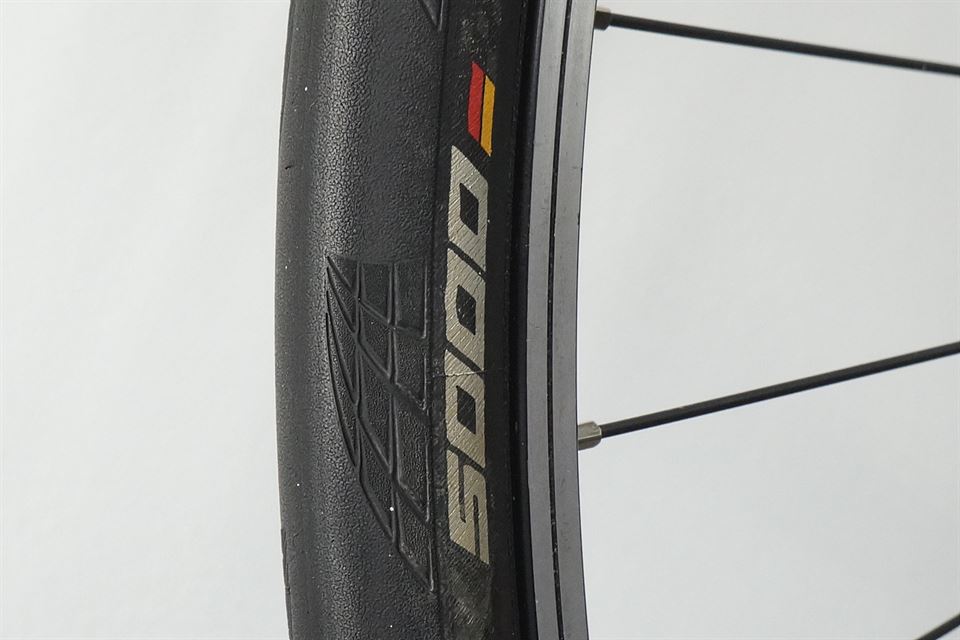
GP 5000 32-622 (rear) Condition After 1860 Miles / 3000 km:
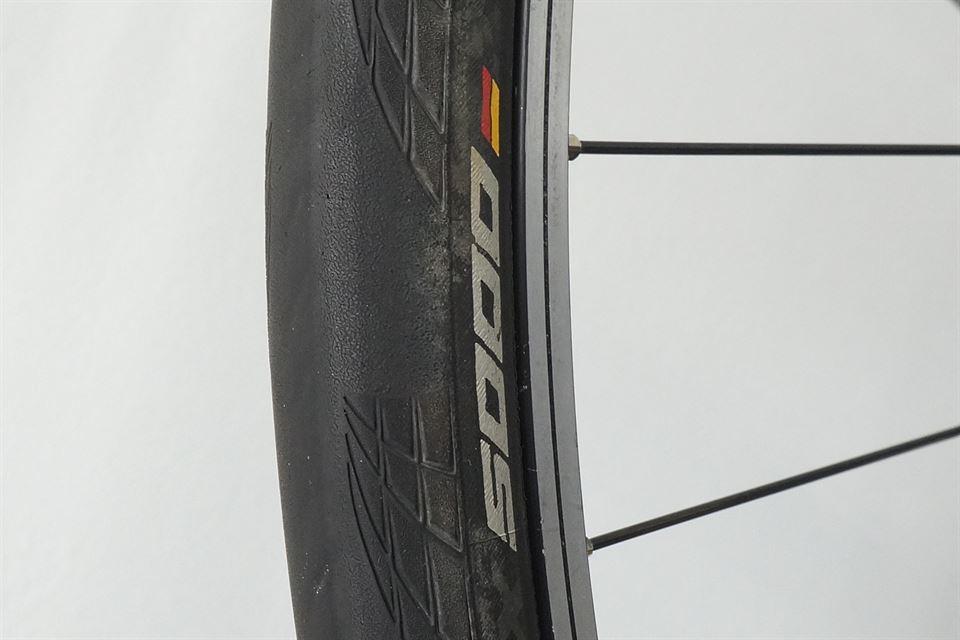
Front 28-622 Measurements After 1860 Miles / 3000 km
| Measurements GP 5000 28-622 (front) | ||||
|---|---|---|---|---|
| 0 miles / 0 km | 620 miles / 1000 km | 1240 miles / 2000 km | 1860 miles / 3000 km | |
| Weight | 235 grams | 233 grams | 233 grams | 233 grams |
| Wear marker | 0.70 mm | 0.65 mm | 0.65 mm | 0.65 mm |
| Tread thickness | 2.6 mm | 2.6 mm | 2.5 mm | 2.5 mm |
| Width | 28.5 mm | 29.0 mm | 29.1 mm | 29.1 mm |
| Rolling resistance 100 psi / 6.9 bars | 10.3 Watts | 11.2 Watts | 11.3 Watts | 11.4 Watts |
| Rolling resistance 80 psi / 5.5 bars | 11.5 Watts | 12.2 Watts | 12.5 Watts | 12.3 Watts |
| Rolling resistance 60 psi / 4.1 bars | 14.1 Watts | 14.6 Watts | 14.9 Watts | 14.6 Watts |
After 1860 miles / 3000 km the front tire has hardly worn. At some points, the centerline mold mark is still visible in the middle of the tire. The front tire has a very easy life with me as I hardly have to corner or brake on my regular lap.
The stretching seems to have stabilized as the tire still has a width of 29.1 mm when inflated to an air pressure of 100 psi / 6.9 bars on a 17 mm inner width rim. The measured weight also stabilized at 233 grams which again indicates there is hardly any wear.
Rolling resistance looks to have stabilized as it now is a bit lower than the measurement at 1240 miles / 2000 km. The differences are so small that this is probably within the margin of error of the tests. The rear tire did see another increase so we'll have to wait longer and keep an eye on the next measurements to draw a conclusion.
| Measurements GP 5000 32-622 (rear) | ||||
|---|---|---|---|---|
| 0 miles / 0 km | 620 miles / 1000 km | 1240 miles / 2000 km | 1860 miles / 3000 km | |
| Weight | 278 grams | 274 grams | 273 grams | 271 grams |
| Wear marker | 0.90 mm | 0.80 mm | 0.70 mm | 0.65 mm |
| Tread thickness | 2.7 mm | 2.5 mm | 2.4 mm | 2.4 mm |
| Width | 31.8 mm | 32.4 mm | 32.6 mm | 32.7 mm |
| Rolling resistance 100 psi / 6.9 bars | 9.7 Watts | 10.5 Watts | 10.8 Watts | 11.3 Watts |
| Rolling resistance 80 psi / 5.5 bars | 11.0 Watts | 11.7 Watts | 12.1 Watts | 12.4 Watts |
| Rolling resistance 60 psi / 4.1 bars | 12.9 Watts | 13.6 Watts | 14.0 Watts | 14.4 Watts |
The rear tire wears much faster than the front and it's starting to look a bit squared off at 1860 miles / 3000 km. Wear rate is still very low and I expect it to start wearing even slower as the tire squares off more and the contact patch gets bigger.
Unlike the front tire, the rear tire stretched a bit more and now measures 32.7 mm wide on a 17C rim, inflated to 100 psi / 6.9 bars. Weight also has gone down a bit more which confirms the higher wear rate of the rear tire.
The rear tire again shows an increase in rolling resistance even though the tread thickness gets less. This is probably the result of the compound and/or casing losing some of its ultra-low rolling resistance properties because of the rolling deformations the tire had to endure.
Conclusion After 1860 Miles / 3000 km.
Wear of the Continental Grand Prix 5000 is extremely low. At the current rate, it looks like they can both easily make it to 6200 miles / 10000 km if the casings hold up. Please keep in mind that my regular lap which makes up 75% of all mileage is very easy on the tires as it consists of a lot of straight roads and no climbing.
I still have to endure my first puncture with these tires which shows they offer good enough puncture resistance if you do not live in an area where punctures are common.
Rolling resistance of the front tire seems to have stabilized while the rear tire continues the trend of an increased rolling resistance as the miles go by. We'll have to wait longer to draw a full conclusion as the differences are small and the margin of error of the tests is ± 3%.
The trend does seem to indicate that the rolling deformations cause the rolling resistance to increase. The rear tire takes a bigger load and we see rolling resistance rising at a faster rate when compared to the front tire.
Second Update at 1240 miles / 2000 km
Ride Statistics and Visual Inspection
| Ride statistics | |||
|---|---|---|---|
| First update | Second update | Total | |
| Days on bike | 180 days | 91 days | 271 days |
| Total distance | 620 miles / 1000 km | 620 miles / 1000 km | 1240 miles / 2000 km |
| Wet roads | 101 miles / 162 km | 107 miles / 171 km | 208 miles / 333 km |
| Dry roads | 523 miles / 838 km | 518 miles / 829 km | 1042 miles / 1667 km |
| Average temperature | 12.5 C | 18.3 C | 15.4 C |
| Average speed | 17.6 mph / 28.2 km/h | 18.3 mph / 29.3 km/h | 18.3 mph / 28.8 km/h |
| Inflation pressure | 65 psi / 4.5 bars | 65 psi / 4.5 bars | 65 psi / 4.5 bars |
| Flat tires | 0 | 0 | 0 |
After 1240 miles / 2000 km, the tires still look good but they have now lost their new tire look. The front tire looks best as the tread hardly wears. The rear 32-622 is now starting to show some wear in the middle of the tread. The casings of both tires are still undamaged.
This time around, total time on the bike was much shorter because the weather improved and a long-time knee injury didn't torture me as much.
Luckily, I once again had 0 flat tires which is not bad as I still didn't have a flat tire with this pair of Grand Prix 5000. After removing the tires I have checked both tires carefully and removed about 15 pieces of stone chip / glass. The pieces of stone chip / glass were stuck in the rubber but seemed to have been stopped penetrating the tire further by the casing / anti-puncture layer.
GP 5000 28-622 (front) Condition After 1240 Miles / 2000 km:
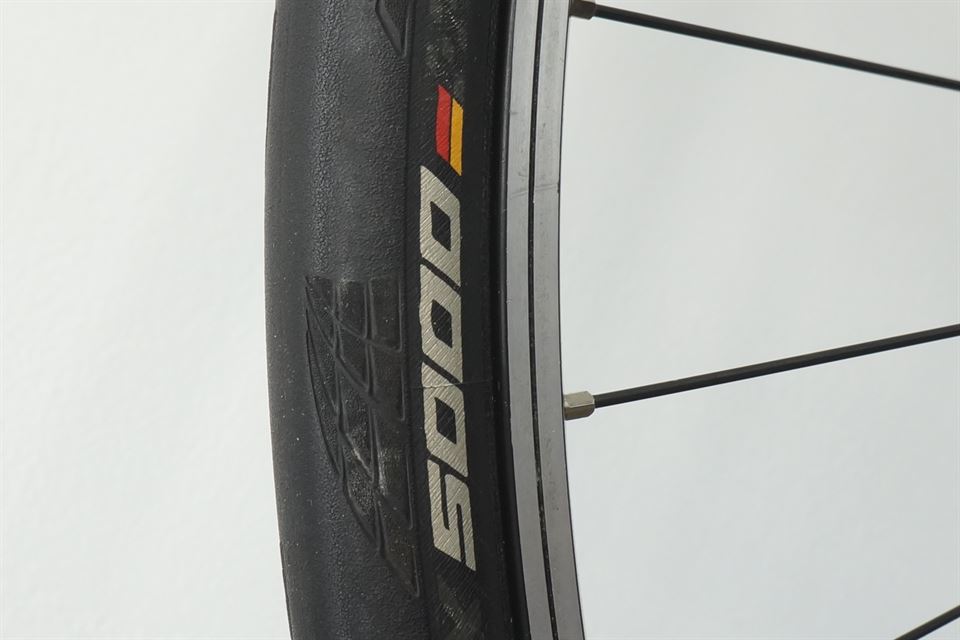
GP 5000 32-622 (rear) Condition After 1240 Miles / 2000 km:
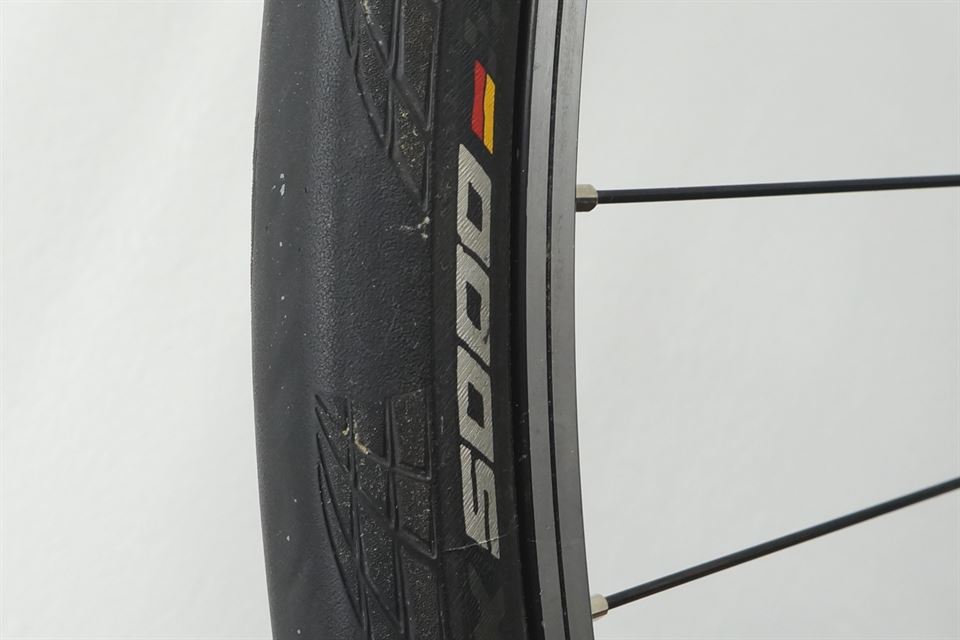
Front 28-622 Measurements After 1240 Miles / 2000 km
| Measurements GP 5000 28-622 (front) | |||
|---|---|---|---|
| New 0 miles / 0 km | 620 miles / 1000 km | 1240 miles / 2000 km | |
| Weight | 235 grams | 233 grams | 233 grams |
| Wear marker | 0.70 mm | 0.65 mm | 0.65 mm |
| Tread thickness | 2.6 mm | 2.6 mm | 2.5 mm |
| Width | 28.5 mm | 29.0 mm | 29.1 mm |
| Rolling resistance 100 psi / 6.9 bars | 10.3 Watts | 11.2 Watts | 11.3 Watts |
| Rolling resistance 80 psi / 5.5 bars | 11.5 Watts | 12.2 Watts | 12.5 Watts |
| Rolling resistance 60 psi / 4.1 bars | 14.1 Watts | 14.6 Watts | 14.9 Watts |
Wear of the front 28-622 Grand Prix 5000 tire still seems to be non-existent. Tread thickness has now gone down from 2.6 mm to 2.5 mm but that's probably because unrounded, it went from 2.62 to 2.53 mm. At this rate, the tread will probably last longer than the rest of the tire.
The front tire again stretched just a little bit more and is now 29.1 mm wide on a 17C rim inflated to an air pressure of 100 psi / 6.9 bars.
The rolling resistance tests show us that rolling resistance has once again gone up. This time the rise in rolling resistance wasn't as dramatic and it could well be that we're now reaching a level where the rolling resistance will stabilize.
| Measurements GP 5000 32-622 (rear) | |||
|---|---|---|---|
| New 0 miles / 0 km | 620 miles / 1000 km | 1240 miles / 2000 km | |
| Weight | 278 grams | 274 grams | 273 grams |
| Wear marker | 0.90 mm | 0.80 mm | 0.70 mm |
| Tread thickness | 2.7 mm | 2.5 mm | 2.4 mm |
| Width | 31.8 mm | 32.4 mm | 32.6 mm |
| Rolling resistance 100 psi / 6.9 bars | 9.7 Watts | 10.5 Watts | 10.8 Watts |
| Rolling resistance 80 psi / 5.5 bars | 11.0 Watts | 11.7 Watts | 12.1 Watts |
| Rolling resistance 60 psi / 4.1 bars | 12.9 Watts | 13.6 Watts | 14.0 Watts |
The rear 32-622 Grand Prix 5000 shows more wear but at the current rate, it still looks like it's going to last somewhere around 5000 miles / 8000 km if the rest of the tire holds up.
The rear tire also stretched a bit more and is now 32.6 mm wide on our 17C rim, inflated to 100 psi / 6.9 bars.
Although the rear Grand Prix 5000 shows more wear, we see the same pattern in the rolling resistance tests. Rolling resistance has gone up again but at a slower rate than after the first 1000 km / 620 miles.
Let's hope we've now reached the point where the tires stabilize and we see rolling resistance go down again as the tread wears down.
Conclusion After 1240 Miles / 2000 km.
Treadwear of the Continental Grand Prix 5000 is very low. It looks like the tread is going to last more than 5000 miles / 8000 km on the rear tire and double that on the front. Most of my riding consists of a flat 40k lap with mostly straight roads and very little stopping and starting which is something that might add to the very low wear rate.
I'm happy about the puncture resistance of the Grand Prix 5000 as I didn't have a flat tire yet. As an extra precaution, I also use latex tubes filled with tire sealant to at least get me home when something small penetrates the tire. I checked both tires carefully but I didn't find anything that went through the tires yet.
After the first 620 miles / 1000 km I was shocked by the large increase in rolling resistance of the Grand Prix 5000. In the last 620 miles / 1000 km, rolling resistance has increased again but not at the alarming rate of the first 620 miles / 1000 km. We might have reached a point where rolling resistance stabilizes or goes down again when the tread wears down.
Scroll to the bottom of this page to find extra info that validates our results. We've performed tests with a Grand Prix 5000 with 60 km on our machine and a Grand Prix 5000 with 500 km on our machine.
First Update at 620 miles / 1000 km
Ride Statistics and Visual Inspection
| Ride statistics | |
|---|---|
| Total distance | 620 miles / 1000 km |
| Wet roads | 101 miles / 162 km |
| Dry roads | 519 miles / 838 km |
| Average temperature | 12.5 C |
| Average speed | 17.6 mph / 28.2 km/h |
| Inflation pressure | 65 psi / 4.5 bars |
| Flat tires | 0 |
After the first 620 miles / 1000 km, both the front 28-622 and rear 32-622 still look brand new. The mold line that runs through the middle of the tire is still easily visible on the front tire and can still be seen on the rear tire when you really look for it. The casings of both tires also still look like brand new.
We've had zero flat tires during the first 620 miles / 1000 km. After inspecting both tires, we did remove 2 small pieces of glass that were stuck in the tread but did not penetrate the tire.
GP 5000 28-622 (front) Condition After 620 Miles / 1000 km:
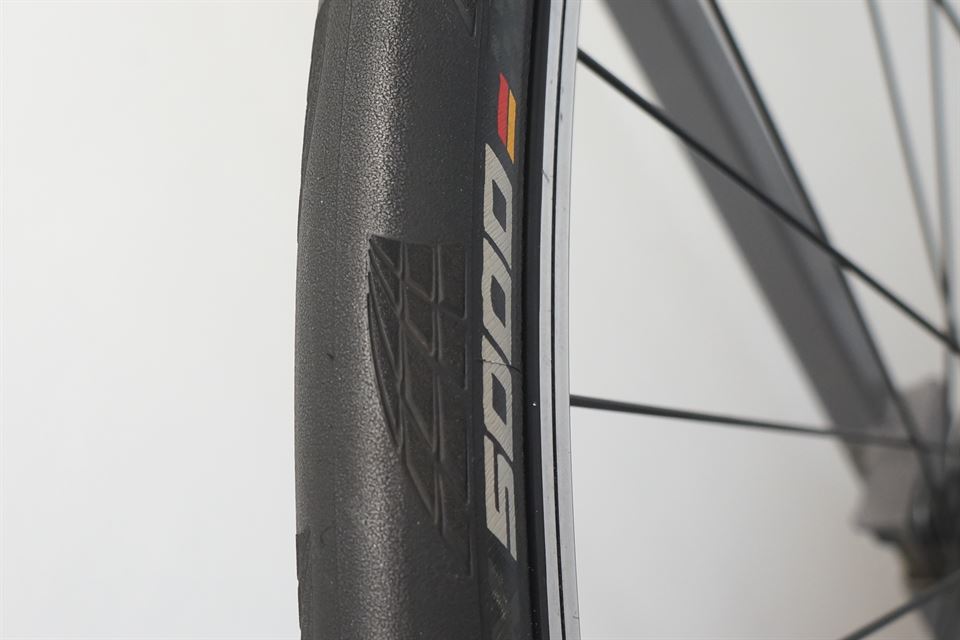
GP 5000 32-622 (rear) Condition After 620 Miles / 1000 km:
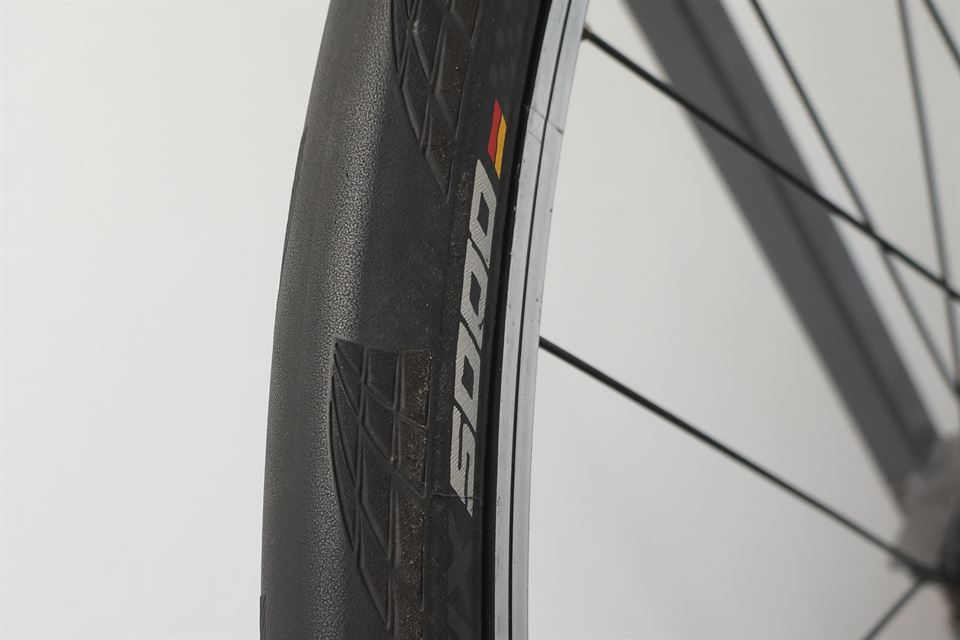
Front 28-622 Measurements After 620 Miles / 1000 km
| Measurements GP 5000 28-622 (front) | ||
|---|---|---|
| New 0 miles / 0 km | 620 miles / 1000 km | |
| Weight | 235 grams | 233 grams |
| Wear marker | 0.70 mm | 0.65 mm |
| Tread thickness | 2.6 mm | 2.6 mm |
| Width | 28.5 mm | 29.0 mm |
| Rolling resistance 100 psi / 6.9 bars | 10.3 Watts | 11.2 Watts |
| Rolling resistance 80 psi / 5.5 bars | 11.5 Watts | 12.2 Watts |
| Rolling resistance 60 psi / 4.1 bars | 14.1 Watts | 14.6 Watts |
Wear of the front 28-622 is very low. Weight has gone down by 2 grams and it looks like the tread is going to last a long, long time.
Something that surprised us was the width of the tire has increased from 28.5 mm to 29.0 mm which shows that the tire will stretch slightly in the first 620 miles / 1000 km even at our relatively low air pressure of 65 psi / 4.1 bars.
To make things clearer about the width measurements: the "new" width measurements were taken after the original rolling resistance tests. This means the tires have already run 60 to 90 minutes on the machine at pressures between 60 - 120 psi. In other words, some initial stretch is already included in the "new" measurements.
The rolling resistance tests tell us that rolling resistance has gone up by 4 - 9 % depending on air pressure which is something you might not expect from well run in tires. We have to wait for more measurements to see if rolling resistance stabilizes at this level, goes down, or goes up further.
| Measurements GP 5000 32-622 (rear) | ||
|---|---|---|
| New 0 miles / 0 km | 620 miles / 1000 km | |
| Weight | 278 grams | 274 grams |
| Wear marker | 0.90 mm | 0.80 mm |
| Tread thickness | 2.7 mm | 2.5 mm |
| Width | 31.8 mm | 32.4 mm |
| Rolling resistance 100 psi / 6.9 bars | 9.7 Watts | 10.5 Watts |
| Rolling resistance 80 psi / 5.5 bars | 11.0 Watts | 11.7 Watts |
| Rolling resistance 60 psi / 4.1 bars | 12.9 Watts | 13.6 Watts |
As expected, the rear 32-622 GP 5000 shows more wear than the front 28-622 GP 5000. Our measurements come in somewhere between 0.10 - 0.20 mm of wear in the first 620 miles / 1000 km.
Just like the 28-622 front, the rear 32-622 has stretched and its width has increased from 31.8 mm to 32.4 mm.
Even though the rear GP 5000 has slightly more wear, rolling resistance of the rear 32-622 GP 5000 has also gone up by 5 - 9 %. It looks like the rubber compound has already lost some of its ultra-fast rolling properties after the first 620 miles / 1000 km even when it's stored under optimal conditions.
Conclusion After the First 620 Miles / 1000 km.
Wear rate of the GP 5000 looks to be very low and puncture resistance also looks to be good as we had 0 flats in the first 620 miles / 1000 km.
Rolling resistance of both the 28-622 and 32-622 has increased by 4 - 9 % depending on air pressure which is something that actually surprised us. We think most people expect tires to become faster rolling when the tread wears down as there will be less material to deform.
Most tires that roll really fast have a lot of rebound in the casing/tread when you take them out of the packaging and deform the tire with your hands. After testing a lot of tires, we generally already know if a tire is fast or slow rolling simply based on how easily the tire rebounds when it's deformed. It looks like the GP 5000 loses some of these properties in at least the first 620 miles / 1000 km.
We'll have to wait for the next measurements to see if rolling resistance stabilizes at this level or the trend continues or reverses.
Ad Buy Continental Grand Prix 5000 at Amazon.com
Validating Our Results
Because the general thinking is that rolling resistance of a tire decreases as it wears, and our results are so counterintuitive, we've performed extra tests that we think proof our results are correct.
We've performed extra tests with a 23-622 and 25-622 Grand Prix 5000 that we used for our Grand Prix 5000 23, 25, 28, 32 mm comparison.
The 23-622 and 25-622 tires, together with the 28-622 and 32-622, were all tested at the beginning of 2019. The 28-622 and 32-622 went on to be used for the endurance test. The 23-622 went straight into storage and was never touched again. The 25-622 was used for inner tube tests and some other general validation testing.
This means the 23-622 has run for about 40 km on our machine and the 25-622 has run for somewhere around 500 km on our machine. During the inner tube tests and validation tests with the 25-622 Grand Prix 5000, we already noticed rolling resistance had gone up slightly. We didn't think much of it at the time as it was within the margin of error of the machine and possibly the inner tubes.
The Grand Prix 5000 endurance test has now taught us the higher rolling resistance of the 25-622 Grand Prix 5000 was probably the result of the tire itself losing some of its ultra-fast rolling properties.
To perform these validation tests, we had to run the 23-622 and 25-622 again with the same inner tube that we used for the GP 5000 comparison back in January. This means it had to be run for another 20 km on the machine to warm everything up so the 23-622 has run for at least 60 km and the 25-622 somewhere around 500 km.
All tests were performed on the same day as the 1240 miles / 2000 km tests of the 28-622 and 32-622 endurance test tires.
Test Results: 23-622 60 km and 25-622 500 km
| 23-622 GP 5000 with 60 km | ||
|---|---|---|
| Tire | 23-622 | 23-622 |
| Tire age (from manufacturing date) | ~ 130 days | ~ 410 days |
| Total distance | 0 km | 60 km |
| Rolling resistance 100 psi | 10.6 Watts | 10.9 Watts |
| Rolling Resistance 80 psi / 5.5 bars | 12.2 Watts | 12.4 Watts |
| Rolling Resistance 60 psi / 4.1 bars | 14.8 Watts | 15.0 Watts |
| 25-622 GP 5000 with 500 km | ||
|---|---|---|
| Tire | 25-622 | 25-622 |
| Tire age (from manufacturing date) | ~ 90 days | ~ 370 days |
| Total distance | 0 km | 500 km |
| Rolling resistance 100 psi | 10.7 Watts | 11.4 Watts |
| Rolling Resistance 80 psi / 5.5 bars | 12.1 Watts | 12.6 Watts |
| Rolling Resistance 60 psi / 4.1 bars | 14.2 Watts | 14.8 Watts |
What we see above is the 23-622 Grand Prix 5000 that was in storage for 280 days comes very close to the original measurements. On average, rolling resistance has increased by 2.0%.
The 25-622 Grand Prix 5000 that was also stored for 280 days, but was also taken out of storage and has seen ~ 500 km on the machine, clearly has a higher rolling resistance. On average, rolling resistance has increased by 5.0%
When we look at the combined numbers of both the 28-622 and 32-622 Grand Prix 5000 that were used for the endurance test, we see rolling resistance has increased by 6.3% after the first 1000 km.
We feel it's safe to conclude that the measurements we provide in the "Grand Prix 5000 Endurance Test" are correct as we were able to get very close to the original numbers with the 23-622 Grand Prix 5000 that was in storage. It's very well possible this increase of 2.0% is partly because the tire has run for an extra 20-40 km between these measurements.
We also feel safe to conclude that, at least the Continental Grand Prix 5000, sees an increase in rolling resistance because it loses some of its ultra-fast rolling properties. We attribute this loss to the deformation of the tire as it rolls. Storage alone doesn't seem to increase rolling resistance all that much. This increase in rolling resistance seems to be the highest in the beginning and, based on our 2000 km endurance test results, seems to level off at higher mileages.
Worn Samples Sent in by Website Visitors
The tires below were sent in by website visitors. Included is a short description of how many miles, flat tires etc. As these are sent in by users, there is no guarantee to the accuracy of this information.
Please keep in mind that these tires were not tested when they were new. The "New GP5000" data in the charts is the data we have from our own samples of the GP5000.
Sample 1
Sample 1 came in with a complaint that this tire was worn in 1120 miles / 1800 km and there were 7 flats during that time. The previous set of the GP5000 lasted 5300 miles / 8500 km with 2 or 3 flat tires. The question was if there are 2 different versions of the GP5000.
- 1120 miles / 1800 km in 6 weeks
- 7 flat tires
- 25-622 size
Sample 2a and 2b
These were sent in by a dutch user who was happy with them and replaced by another set of 25-622 GP5000.
- 5600 miles / 9000 km in 14 months
- 0 flat tires
- Both 25-622 size
Sample 3 (Wolfpack Road Race)
This one was sent in by a member from Spain. The Wolfpack Road Race also sees quite a big increase in rolling resistance.
The when new rolling resistance is estimated from the 26-622 Wolfpack Road Race that we tested last year. As this exact tire was not tested when new, there can be some differences.
- 3906 miles / 6285 km in 5 months
- 50% rear tire / 50 % front tire
- 24-622 size
- 2 punctures
